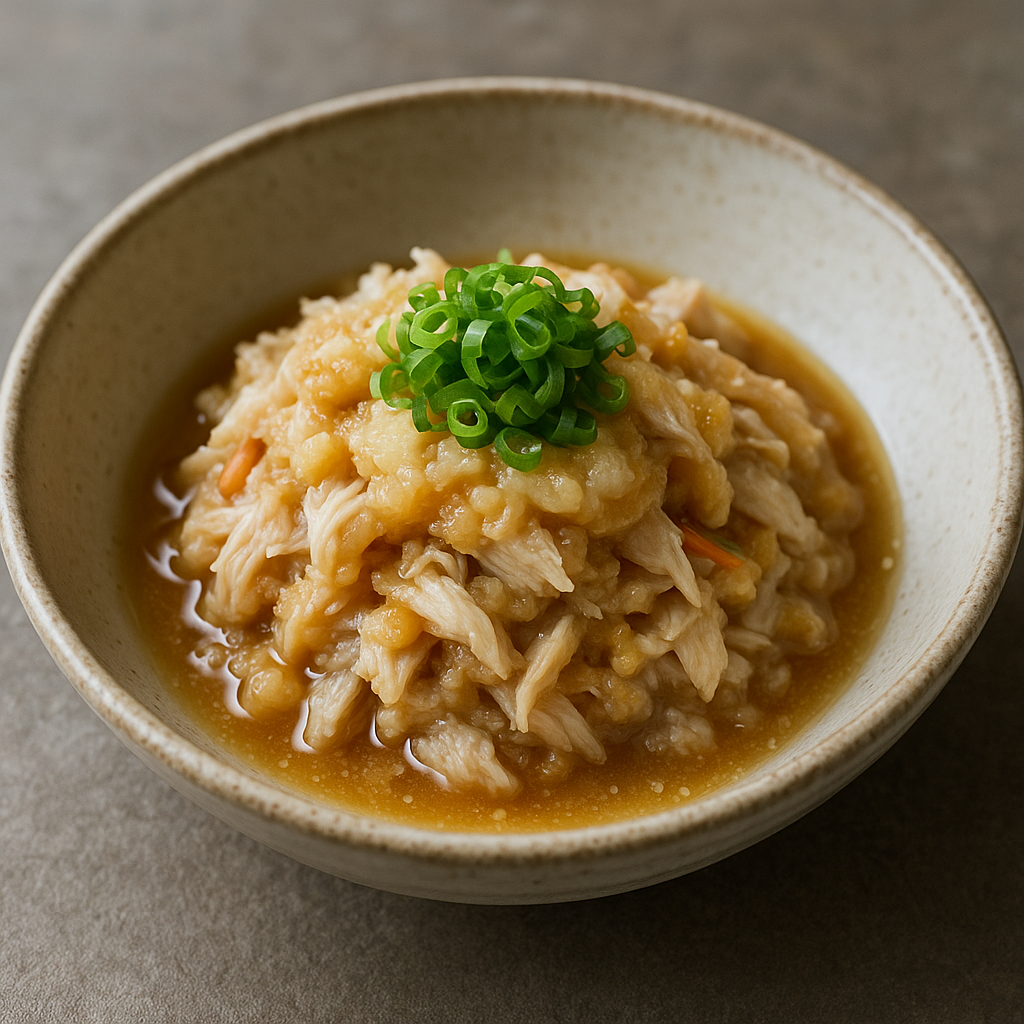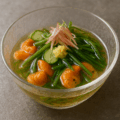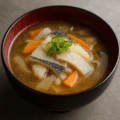鮫のすくめの特徴
熱々の身を酢味噌で“包む”津軽の一皿
ゆでたサメの頭(または切り身)の身をほぐし、熱いうちに大根やキャベツと酢味噌で和える郷土料理。淡白な身に酢味噌の甘酸っぱさが絡み、軟骨由来のぷるっとした食感も楽しめます。名称の「すくめ」は“酢でくるむ(包む)”の意で、津軽では「すぐめ」とも呼ばれます。
正月にも欠かせない“無駄なく活かす”知恵
魚が貴重だった時代、サメの頭やアラまで使い切るために生まれた料理で、正月料理としても親しまれてきました。青森ではアブラツノザメの流通が多く、家庭でも身近な素材です。
鮫のすくめのレシピ
材料(4人分)
- サメ(アブラツノザメなど)… 400g(頭の身をゆでてほぐす )
- 大根 … 300g(薄切りをさっと湯通し または 大根の鬼おろし200g)
- (好みで)キャベツ … 200g(細切り・塩少々でもみ、水気を切る)
- 長ねぎ … 適量(小口切り)
酢味噌(目安)
- 白味噌 … 60g
- 酢 … 大さじ3
- みりん … 大さじ1(煮切る)
- 砂糖 … 大さじ1(好みで加減)
- (好みで)和がらし 少々
作り方
- 下ゆで:大鍋に湯を沸かし、サメの頭や切り身を入れて弱めの中火で10〜15分。身がほろりと外れる程度まで火を入れる。ザルに上げて粗熱をとり、骨・軟骨・皮をより分けて身を大きめにほぐす(軟骨は細かく刻んで加えても良い)。
- 野菜の準備:大根薄切りは熱湯で10〜20秒だけ湯通しして水気を拭く。大根おろしを使う場合は軽く水気を切る。キャベツは塩もみ後に水気を絞る。
- 酢味噌:白味噌・酢・煮切りみりん・砂糖(・和がらし)をよく混ぜる。
- 和える:ボウルにサメの身を入れ、酢味噌の半量を絡める。続いて大根(または大根おろし/キャベツ)と長ねぎを加え、残りの酢味噌で全体をさっと和える。温かいまま、または粗熱が取れてから供する。
シェフのワンポイントアドバイス
- 身は熱々のうちに酢味噌と和えると味がなじみやすい。
- 臭みが気になる場合は、下ゆでの湯に生姜薄切りや酒少々を加えると穏やかになります。
- 大根は薄切り/おろしのどちらでも可。おろしは水分を絞りすぎない方が口当たりがよいです。
栄養価(1人分の目安)
- エネルギー:約160〜230 kcal
- たんぱく質:18〜25 g(サメ由来)
- 脂質:4〜8 g
- 炭水化物:8〜16 g
高たんぱくで比較的低脂質。大根やキャベツで食物繊維を補えます。
歴史
サメ文化が根づく津軽の正月料理
津軽では古くからサメを食用にしてきた歴史があり、特にアブラツノザメの頭を使う「鮫のすくめ」は正月の定番。語源は“酢で包む”で、地域により大根おろしと和える作り方も伝わります。
English Version
Features of “Same no Sukume” (Shark with Vinegared Miso)
A Tsugaru dish that “wraps” piping-hot meat in sweet vinegar miso
Flesh from boiled shark head (or cuts) is flaked and, while still hot, tossed with daikon or cabbage and a sweet vinegared miso. The mild meat takes on the tangy-sweet dressing, and you can enjoy a gentle, bouncy bite from cartilage. The name sukume is said to derive from “to wrap with vinegar,” and it’s also called “sugume” locally.
No-waste wisdom that remains a New Year staple
In days when fish was precious, heads and trimmings of shark were used fully. The dish took root as part of New Year fare in Tsugaru, where spiny dogfish (aburatsuno-zame) is commonly distributed.
Recipe
Ingredients (4 servings)
- Shark (e.g., aburatsuno-zame) … 400 g (boil head meat and flake while hot)
- Daikon … 300 g (either briefly blanched thin slices or coarsely grated 200 g)
- (Optional) Cabbage … 200 g (fine shred; massage with a little salt, squeeze)
- Scallion … to taste (thinly sliced)
Vinegared miso (guide)
- White miso … 60 g
- Vinegar … 3 tbsp
- Mirin … 1 tbsp (boiled to remove alcohol)
- Sugar … 1 tbsp (to taste)
- (Optional) Japanese mustard … a little
Instructions
- Parboil the shark: Bring a pot of water to a boil, add the head or cut pieces, and simmer gently 10–15 minutes until the flesh separates easily. Drain, cool just enough to handle, then separate bones/cartilage/skin and flake the meat into large pieces (finely chop soft cartilage if adding).
- Prep vegetables: For daikon slices, blanch 10–20 seconds and pat dry. If using grated daikon, drain lightly (don’t over-squeeze). For cabbage, salt-massage and squeeze well.
- Make the dressing: Stir together white miso, vinegar, boiled-off mirin, sugar (and mustard if using) until smooth.
- Toss: Put the hot shark flakes in a bowl and coat with half the dressing. Add daikon (slices or grated) and cabbage/scallion, then fold in the remaining dressing. Serve warm or at room temperature.
Chef’s Tips
- Toss the meat with dressing while it’s still hot so flavors penetrate well.
- If aroma is strong, add a few ginger slices or a splash of sake to the boiling water.
- Daikon works both sliced and grated; with grated, avoid squeezing too dry for a better mouthfeel.
Nutritional Value (per serving, approx.)
- Calories: ~160–230 kcal
- Protein: 18–25 g (from shark)
- Fat: 4–8 g
- Carbohydrates: 8–16 g
High in protein and relatively low in fat; daikon or cabbage adds dietary fiber.
History
A New Year classic grounded in Tsugaru’s shark-eating culture
Shark has long been part of the Tsugaru table. “Same no Sukume,” especially using head meat of aburatsuno-zame, is a seasonal regular at New Year. The etymology points to “wrapping with vinegar,” and some households mix in grated daikon instead of slices.



何でも質問してください!